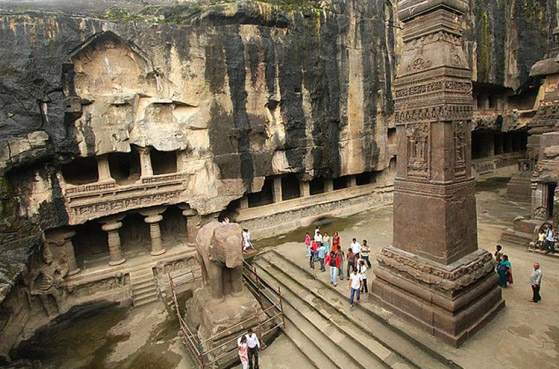 Location: Ellora, Aurangabad, Maharashtra, India
Location: Ellora, Aurangabad, Maharashtra, India
Main Deity: Kailashanatha (Shiva)
Establishment Date: Somewhere around 8th Century from 756-773 CE
Creator: Most Likely Krishna
By Train- The nearest railway station to the temple is the Aurangabad railway station. The distance between the temple and the Aurangabad railway station is around 30kms. Trains are also available from major cities like Pune, Ahmednagar, Mumbai, Maharashtra and Nashik.
By Road- The nearest city to the temple is Kailash temple and is well connected with the temple via road. A plenty of buses and taxis are available to reach in Aurangabad to help reach the temple. Also, the Aurangabad city is properly connected with major cities like Satara, Pune, Nashik, Mumbai, Ahmednagar and Kolhapur.
By Air- Aurangabad airport is located at around 15 kms from the Kailash temple and is the closest airport to the Kailash temple. The city of Maharashtra in India is very well-connected to the Aurangabad airport.
From Aurangabad – 30 Km
From Kopargaon – 88 Km
From Jalna – 90 Km
From Malegaon – 113 Km
From Dhule – 120 Km
From Sangamner – 134 Km
From Jalgaon – 157 Km
From Nashik – 169 Km
From Pune – 256 Km
From Mumbai – 341 Km
Ellora Caves
Ajanta Caves
Aurangabad City
Aurangabad City
Nashik City
Melghat Tiger Reserve
Yawal Wildlife Sanctuary
The Kailasha temple is one of the well-known and the largest temples of the Hindus and is located in the city of Ellora in Maharashtra in India. Because of it implausible size, sculpture, architecture, it is considered as one of the most outstanding cave temples in India. The 16 caves of the Kailashnath temples are of the 32 cave temples collectively known as caves of Ellora. Its construction is related to the 8th century under the rein of Krishna I of the Rashtrakuta during the time 756- 773 CE. The architecture of the temple is also reminiscent of the Chalukya and Pallava styles.
There isn't any dedicated inscription on the temple but the temple definitely relates to the rulers of the Rakshtrakuta. The temple can be linked to the Krishnaraja based on two epigraphs:
The Kailash temple is famous for the vertical excavation that it features. The top down excavation over the original rock that moves from top to the bottom is the best part of its construction. During the construction of the temple, the traditional method of construction had been strictly followed by the master architects of the temple as it could not have been done from the front end. There is a mention in the medieval legend about the construction of this great Kailash temple. The Katha-Kalpataru has the earlier mention of the legend of this temple. As per the legend, the local king of the area once suffered from disease and as a result his wife prayed to the almighty Shiva to cure his husband at Elapura. She also vowed to get a temple constructed on the name of Shiva and he would not eat until she sees the top of the temple. After the king got cured, she wanted the king to build the temple as her vow. But many architects said that it would take a great deal of time to build the temple with the complete Shikhara. But luckily there was an architect named Kokasa who give an assurance that the top of the temple would be built within a week's time. The temple was then called as Manikeshwar. Kokasana was the chief architect of the Kailasa temple.